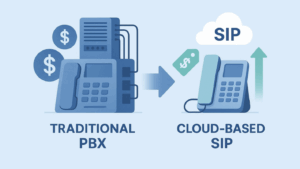
What is ATA and How Do You Know if Your SIP Setup Needs One?
Old analog systems are slowly going offline. Many countries are already well on their way to analog switch-off compliance by 2025. However, employees still spend about 400 minutes per day on the phone, so voice communications systems are far from shutting down. That is one reason why 70% of all Canadian and U.S. businesses use SIP trunks for these calls now.
When your company switches to a SIP trunk line, you may want to keep all the customizations and features of your legacy Private Branch Exchange (PBX) system. That’s where the answer to “What is ATA?” comes into play.
The acronym ATA stands for Analog Telephone Adaptor. It’s a device that bridges standard telephones and PBXs to a network so calls travel over the internet instead of directly over copper wires.
There are several different kinds of ATAs. All of them are a physical bridge between a phone and a network device. Some adaptors perform analog-to-digital conversion and connect directly to a Voice over Internet Protocol (VoIP) server. Other ATAs use software rather than hardware to perform the tasks.
The simplest type of ATA uses a USB connector to attach to a server, computer or other internet-connected devices. At the other end, one or more R-11 jacks allow connection to telephones, faxes and more. These adaptors look like a simple box.
This type of ATA depends on software to digitize voice data to be transmitted over the internet. It is meant for a single line, not for a PBX. It can cause garbled or incomplete calls when used with a PBX.
In a business setting, the usual ATA has a bank of telephone jacks and an RJ-45 connection to a LAN 10/100BaseT Ethernet hub. The ATA digitizes voice data, and it is a VoIP gateway, simplifying the phone system’s configuration by allowing the service provider to handle complex programming and management.
Related: All About Voice Services – Changing the Working World
What Is VoIP?
VoIP means that you can make phone calls that travel via the internet rather than through analog phone lines. VoIP takes analog voice signals and translates them into digital signals that travel via broadband lines.
Before VoIP, voice and fax calls traveled via the Public Switched Telephone Network (PSTN). This is the same network that is now slowly going offline. Despite analog calls being reliable and straightforward, they aren’t flexible enough for current business needs. For instance, they do not allow for video conferencing, messaging, chat or document sharing, all of which are now work norms.
When you want to add or remove lines, include new devices or change addresses, you need to bring in a technician and purchase hardware. The technology is static versus mobile, requiring users to be onsite to utilize any functionality.
On the other hand, VoIP phones work using internet protocol instead of phone lines. It relies on the internet to deliver your calls and uses a server in the cloud to perform switching and routing duties. An on-site router connects calls to the internet. Signal packets travel outbound to the receiving telephone (also internet or traditional.)
Because VoIP works via the cloud, your people can work from anywhere at any time as long as they have an internet connection. If you have a remote workforce, VoIP or a similar cloud-based technology is a must.
VoIP connects to virtually any device. You can effortlessly add smartphones and desktop software, among others. Employees can even use their personal devices as long as your organization has adequate security measures in place.
Why Keep Your Legacy Private Branch Exchange?
Your legacy PBX could act as the bridge between the phone company lines and your business. The ATA would then serve as the bridge between your company and your SIP trunk service. The right kind of ATA makes this transition seamless.
PBX systems aren’t new. They have been used for decades to handle call routing and switching between businesses and the telephone network. A PBX is usually a large, expensive machine located at a company’s office. It can’t be easily expandable or changed. If you have one, you probably count on your current PBX programming to:
-
Use of more than one telephone line
-
Manage incoming and outgoing calls
-
Have multiple internal extensions or sharing limited outbound lines
-
Switch calls between internal lines
-
Facilitate internal communication within the business
-
Add voicemail, automated response and other features
The pandemic forced many people to work remotely, and businesses could not take valuable time out to reprogram and retrain employees for a phone system. As mentioned in the section “What is ATA?”, SIP trunks became more popular to solve this problem. For companies that needed to maintain their PBX functionalities, ATAs were necessary.
If you choose to keep your existing PBX, SIP trunks give you the flexibility to take advantage of low-cost calling. In a per-line cost comparison, the use of VoIP technology can save at least 40%, possibly more.
What If You Don’t Want to Keep Your Old PBX?
Another viable scenario for companies is to remove their PBX system altogether. In the past, the only solution would have been a “forklift upgrade,” where you put the old system on a truck and replaced it with a new one.
Today, a hosted PBX is the option. It moves the phone system’s configuration and maintenance responsibilities to a service provider. You handle only the handsets and cords, while the service provider does the complex programming and configuration.
Hosted systems locate the PBX at the service provider’s center. This frees up your valuable real estate.
There are some out-of-pocket costs, such as all new handsets, cords, etc., but this could be a solution with multiple other benefits:
-
Low cost
-
Flexibility
-
No ATAs needed
-
Easy to expand
If you are a legacy PBX owner, you know that maintaining a PBX on-premises requires expensive IT technicians with telecom experience. Also, consider capital outlay and depreciation of the equipment, plus the cost of the space that houses it.
A cloud-based PBX gives you the functions you want for a monthly charge and a minimal capital outlay. These are expensed annually instead of counting as depreciable assets.
When looking for a PBX, you want one that is flexible and scalable. A cloud-based system only requires a few keystrokes to make changes, increase or decrease the number of extensions, add or change locations, access the system and manage it from anywhere with an internet connection.
In combination with a premium SIP trunk service, you could have a large corporation system at small-business prices.
Is There an Alternative to Legacy or Hosted Virtual PBX Systems?
At this point, the question “What is ATA?” becomes unnecessary. If you choose PBX as a software service, software controls everything you need: You load it on a PC or the local server you own or control, and that’s it.
You could hire a consultant to help you get started, but most infrastructures allow for DIY configuration and customization. Top providers will offer compatibility with almost all open source systems.
Related: The 5 Best PBX Systems For Your Business
The Role of ATAs in SIP Setups
Analog Telephone Adapters (ATAs) are pivotal in bridging the gap between traditional analog telephones and modern SIP-based voice communications systems. By connecting existing analog devices, such as phones and faxes, to a SIP trunk, ATAs enable businesses to leverage the benefits of Voice over Internet Protocol (VoIP) technology without overhauling their entire infrastructure.
In a SIP setup, an ATA functions as a gateway, converting analog voice signals into digital signals that can be transmitted over the internet. This conversion allows businesses to make and receive voice and fax calls over the internet, bypassing the need for traditional telephone lines.
For businesses looking to maintain their existing analog devices while enjoying the flexibility and cost savings of SIP trunking, ATAs are invaluable. They eliminate the need for replacing current devices, thereby reducing the initial costs associated with implementing a SIP-based voice communications system. This makes the transition to modern communication technologies smoother and more cost-effective.
Benefits of Using an ATA
Incorporating an ATA into your SIP setup offers a multitude of benefits:
-
Cost Savings: ATAs allow businesses to use their existing analog devices, significantly reducing the upfront costs of transitioning to a SIP-based voice communications system.
-
Flexibility: By connecting analog devices to a SIP trunk, ATAs provide the flexibility and scalability inherent in VoIP technology, making it easier to adapt to changing business needs.
-
Improved Call Quality: Modern ATAs are equipped with advanced features like echo cancellation and jitter buffering, ensuring clear and reliable voice communications.
-
Simplified Management: ATAs are designed for easy configuration and management, enabling businesses to quickly set up and maintain their voice communications systems without extensive technical expertise.
Features of ATAs
ATAs come with a variety of features that enhance their functionality and ease of use:
-
Analog-to-Digital Conversion: ATAs convert analog voice signals into digital signals, facilitating their transmission over the internet.
-
SIP Protocol Support: They support the SIP protocol, ensuring compatibility with SIP-based voice communications systems.
-
Voice Codec Support: ATAs support multiple voice codecs, such as G.729 and G.711, to deliver high-quality voice communications.
-
Echo Cancellation: This feature helps in maintaining clear and reliable calls by eliminating echo.
-
Jitter Buffering: Jitter buffering ensures that voice communications remain unaffected by internet latency, providing a stable call experience.
-
Web-Based Configuration: Many ATAs offer web-based configuration, simplifying the setup and management of your voice communications system.
-
TFTP Auto-Provisioning: Some ATAs support TFTP auto-provisioning, making it easier to configure and manage devices across the network.
By understanding and leveraging these features, businesses can optimize their voice communications systems, ensuring they are both efficient and cost-effective.
Clear Voice Communications With SIP Trunks and Fewer Call Quality Concerns
In the past, VoIP calls were easy to distinguish. They exhibited poor sound quality and unreliable communications. A modern, stable SIP trunk eliminates these challenges. VoIP systems today offer call quality virtually indistinguishable from traditional wired systems at a fraction of the cost.
There are far fewer call-quality concerns on modern systems. Voice calls that use a high-quality, stable SIP trunk service don’t have mangled or dropped calls.
Internet service quality is of concern, but with sufficient up/down bandwidth to simultaneously handle voice and data, there are no call quality issues. Most virtual PBX systems allow you to select one service provider to simplify billing and resolve many support challenges.
A credited SIP trunking service provider will allow you to bring your bandwidth or PBX and recommend the best equipment for your business.
How to Choose the Right Premium SIP Trunk Service
Choosing the right SIP trunk service is critical to make the most out of your migration from the old copper line systems.
It is helpful for you to determine if you want to keep a legacy PBX with the switch to VoIP. Don’t just look at call quality, but compare costs. A legacy PBX may be ideal if your system has many customizations or remains a tax asset.
PBX systems as software, on the other hand, mean that you can handle the responsibilities for configuration and maintenance. No calling IT needed because of incorrect call routing, poor sound quality, or dropped calls. You can quickly do the maintenance online.
SIP.US trunk service can help you create a flexible phone system that works for your business. Can your PBX handle work pattern shifts or seasonal variances.? Let us help you explore your options. Contact us now and get started for free.



